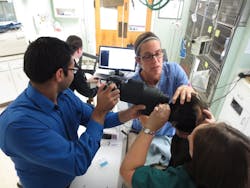The remarkable success of optical coherence tomography (OCT) has spawned significant competition and attendant price pressure. As the technology has matured and volumes have grown, overall costs associated with several OCT components have gone down, bringing the technology to a new inflection point. Now, prices have reached a threshold where OCT can be used by care providers not just for humans, but also for companion animals. That's because medical care of companion animals is usually covered out of pocket, so most clinics cannot justify spending large amounts on medical technologies.
Being tested now in veterinary practice, an OCT system specifically for clinical use on large (and large-ish) animals including cats, dogs, horses, and primates, developed by Wasatch Photonics (West Lafayette, IN), will allow veterinary ophthalmologists to offer retinal and corneal scans. Thus, vets will be able to look at color fundus images and retinal cross-sections to diagnose problems related to the macula as well as retinal epithelial and nerve fiber layers, and to investigate an eye's anterior segment for infection and cataract detection.
The system runs about half the price of OCT systems for humans. "Low costs of early diagnostics will encourage more regular check-ups and prevent costly and debilitating progression of disease," said Nishant Mohan, Ph.D., director of OCT products for Wasatch. Mohan explains that beyond price, the development team gave particular attention to creating a light, compact system that a veterinary worker can easily use to guide the animal while doing the exam.
Dr. Clare Bonifant of Armadale Animal Hospital (Raleigh, NC) told BioOptics World, "Our clientele is interested in any diagnostic tool that would guide treatment of conditions that are discernible." She said that her general practice refers to specialists for procedures beyond the basics, and that "If we refer patients to vets with this technology and it's needed, they are willing to pay for the diagnostic." That sounds like good news for Wasatch.
Bonifant also thinks such technology could fit into a regular, non-specialty practice if it had "a champion within the practice-a doctor willing to learn the technology and promote it and integrate it into regular wellness screens, possibly as part of an eye care package." So while it's not yet clear just how veterinarians will leverage the capabilities of OCT day to day, the fact that an OCT system is available specifically for animals is a first step toward better health for many.
About the Author

Barbara Gefvert
Editor-in-Chief, BioOptics World (2008-2020)
Barbara G. Gefvert has been a science and technology editor and writer since 1987, and served as editor in chief on multiple publications, including Sensors magazine for nearly a decade.
